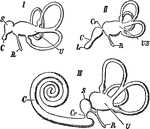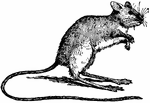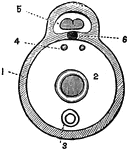Clipart tagged: ‘vertebrate’

Horizontal Section of a Vertebrate Brain
Diagrammatic horizontal section of a vertebrate brain. Mb, midbrain: what lies in front of this is the…

Internal Ear of Vertebrates
Internal ear of different vertebrates. I, fish; II, bird; III, mammal. Labels: U, utriculus with semicircular…

Jumping Mouse
The Jumping Mouse (Zapus hudsonius) is a N. American, jerboa-like mouse, with long hind legs, a very…

Urinogenital Organs of a Vertebrate
Diagrams illustrating the development of the urinogenital organs of a vertebrate. A, pronephros and…

Vertebrate and Invertebrate
A, Diagrammatic transverse section through the body of a vertebrate. B, A similar section through a…

Vertebrate Eye
"Diagrams illustrating two stages in the development of the vertebrate eye. A, showing the relation…

Section of Vertebrate
Diagrammatic sections of the ideal vertebrate. A, sagittal section showing the brain and spinal cord…

Transverse Section of a Vertebrate
A diagram of a transverse section of a vertebrate. Labels: 1, the walls; 2, digestive organs; 3, circulatory…

Forearms of vertebrates
"Fore limbs of vertebrates showing similarity of structure. A, salamander; B, turtle;…